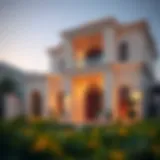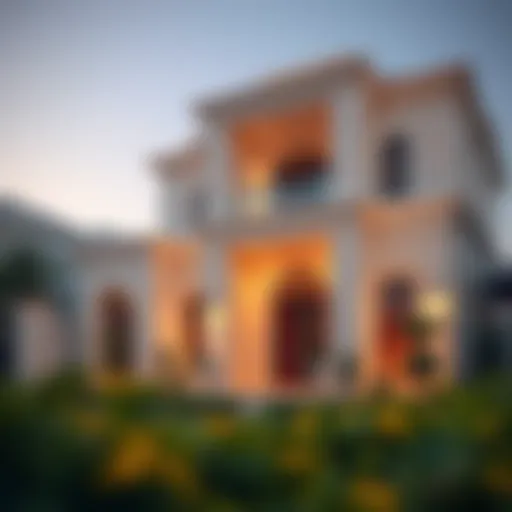The W Tower: An In-Depth Look at Dubai's Icon
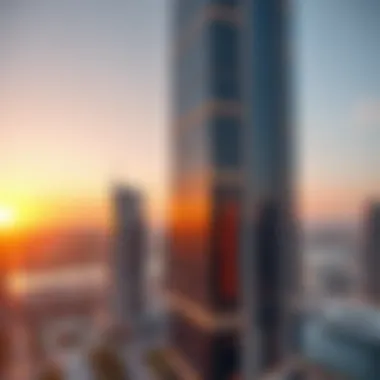
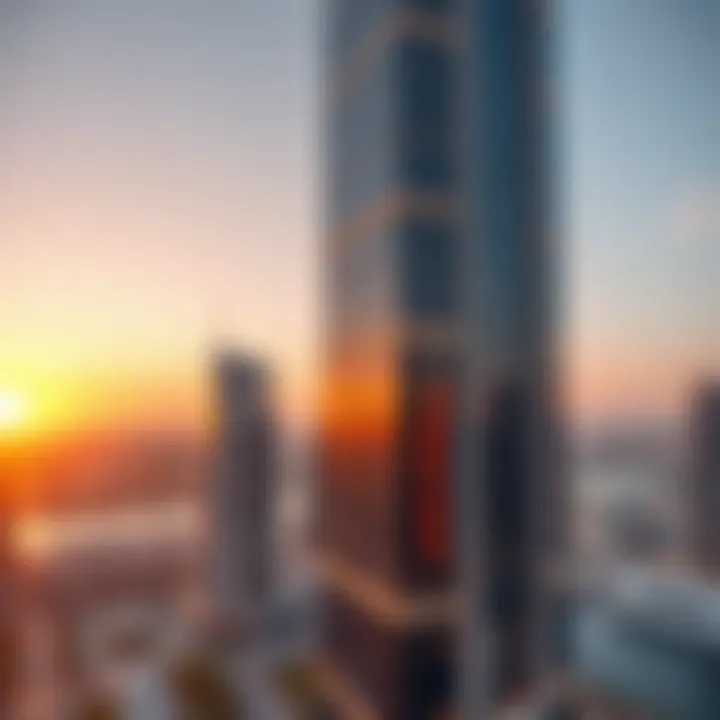
Intro
Dubai’s skyline is known for its iconic structures, but few stand as tall as the W Tower. This towering marvel doesn’t just scrape the sky; it embodies the essence of modern architecture in one of the world’s most vibrant cities. Designed with striking aesthetics, the structure serves not only as a visual centerpiece but also as a beacon for investment and growth in the real estate market.
In this article, we’ll explore the various facets of the W Tower—from its groundbreaking design features to its historical context and pivotal role in shaping the real estate landscape in Dubai. By the end, you will have a comprehensive understanding of why the W Tower is more than just a building; it is a significant player in Dubai’s architectural identity and economic future.
Market Insights
As we dive into the real estate dynamics surrounding the W Tower, it's important to grasp the ongoing trends that define Dubai’s market.
Current Trends in Dubai Real Estate
With the world recovering from various economic hurdles, Dubai is witnessing a resurgence in property demand. The allure of the W Tower particularly resonates with investors and expatriates alike. Two trends have become apparent:
- Preference for Luxury Living: As wealth dynamics shift, there’s an increased appetite for upscale accommodations. The W Tower, with its opulent designs, aligns perfectly with luxury living trends.
- Sustainability in Construction: The modern buyer is not only looking for aesthetics but also sustainability. The W Tower incorporates state-of-the-art energy-efficient technologies, making it attractive to eco-conscious investors.
Nobody can ignore the digital transformation impacting real estate as well, such as the rise of virtual tours, enhancing buyer engagement without the need for physical visits.
Predicted Market Growth and Future Opportunities
Real estate experts predict continued growth for Dubai's market, with robust opportunities arising out of the W Tower's establishment. Demand for premium properties remains strong, especially in neighborhoods surrounding the Burj Khalifa region.
Additionally, government initiatives are making it easier for foreigners to invest in local real estate, leading to a vibrant market poised for expansion. Investors are increasingly looking for high-potential spots—areas within reach of the W Tower, which stands as a testament to successful development.
"Dubai is rapidly becoming a global hub for real estate, primarily driven by innovative architectural projects like the W Tower, which amplify its appeal to international investors."
Investment Strategies
Understanding the playing field is half the battle when it comes to real estate investment. With the W Tower as a focal point, let’s dive into strategies designed to help first-time buyers and seasoned investors alike.
Tips for First-Time Buyers
- Research Thoroughly: Knowledge is power. Get familiar with both the W Tower's offerings and the surrounding neighborhood to ascertain value.
- Balance Emotion with Logic: While attractive features of the W Tower may pull at your heartstrings, make sure you’re making wise financial decisions.
- Seek Professional Guidance: Consider hiring an agent who specializes in high-end properties; their insider information can provide an edge in this competitive market.
Analyzing High-Potential Investment Areas
Investing near the W Tower can be advantageous. Here are key areas to consider:
- Business Bay: Proximity to the W Tower while being a commercial hub makes Business Bay desirable.
- Dubai Marina: Known for its waterfront views and luxury living, this area offers potential rental income opportunities.
- Jumeirah Lake Towers: This community boasts affordable options without compromising on luxury attractions.
Thus, exploring the W Tower's impact on real estate trends and evaluative strategies provides substantial insights not just for homebuyers but for anyone keen on making sound investments in Dubai’s complex market.
For more detailed insights, consider exploring resources like Egypt Property or Dubai Land Department for the latest data and market analyses.
Intro to the W Tower
The W Tower is not just a building; it’s a defining feature of Dubai’s architectural narrative, symbolizing innovation and luxury. In a city known for its extraordinary skyline, the W Tower stands tall as a beacon, catching the eye of both residents and visitors alike. By examining the intricacies of this marvel, this article aims to shed light on its pivotal role within the urban fabric of Dubai and the wider implications for the ever-evolving real estate market.
Significance in Dubai's Urban Landscape
Dubai's urban landscape is a vibrant tapestry woven from ambition, culture, and cutting-edge technology. The W Tower adds a unique thread to this fabric, enhancing the skyline with its contemporary design and daring structure. It is not merely another addition to the plethora of structures that populate Dubai; rather, it represents the city’s commitment to pushing the envelope of architectural design and sustainability, guiding the eye upwards.
This tower serves as both a place of leisure and living, melding seamlessly with the other iconic structures that dot the horizon. The significance of the W Tower lies not just in its ability to stand out visually but also in how it integrates with the city’s larger growth strategies. Such buildings foster increased tourism, pave the way for business opportunities, and create a sense of community awareness about modern architectural practices.
Furthermore, its location in the heart of the city positions it as a vital hub, influencing surrounding real estate prices and trends. Observing how the W Tower shapes the urban environment provides critical insights into Dubai's real estate dynamics and investment opportunities for eager stakeholders.
A Brief History of the W Tower
Understanding the W Tower's journey begins with its inception, which is a tale of creativity, ambition, and collaboration. Conceptualized in the early 2010s, its design was brought to life through the vision of international architects passionate about groundbreaking aesthetics and modern functionality. After years of meticulous planning, construction commenced, and the anticipation grew amongst residents and investors alike.
In 2018, the W Tower officially opened its doors, making a significant impact on Dubai’s skyline almost overnight. What once was a barren plot of land transformed into a dynamic center that hosts luxury apartments, office spaces, and an array of leisure facilities. The architectural design embraces both form and function, a hallmark of 21st-century development.
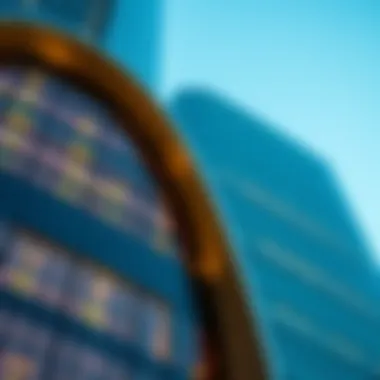
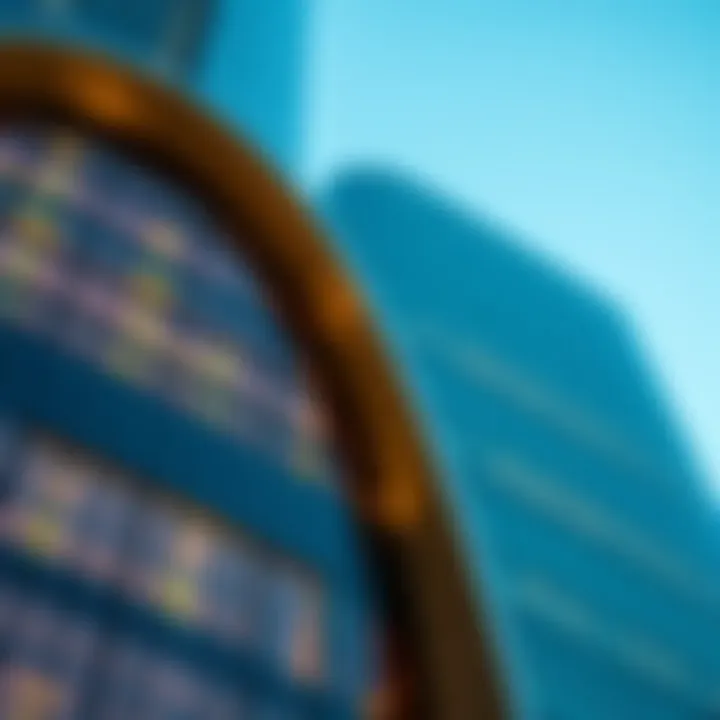
As time marched on, the tower has witnessed Dubai’s rapid development pace. It has become a preferred destination for expatriates and business professionals, encapsulating the modern lifestyle that many seek in today’s world. The W Tower’s adaptability ensures it remains relevant in an ever-changing environment, making it a prime subject for anyone interested in the architectural and economic trends of Dubai.
"The W Tower isn't solely about luxury; it embodies the shift in Dubai toward urban living and corporate synergy."
Closely examining the W Tower reveals not merely a building but a narrative of progress, resilience, and forward-thinking that reflects the spirit of Dubai itself.
Architectural Design Features
The W Tower's architectural design features serve as a critical backbone of not only the structure but also the broader skyline of Dubai. These elements portray a synthesis of style, functionality, and innovation, which align the building with the aspirations of a city known for its bold urban statements. Designed with both aesthetics and livability in mind, the W Tower is a landmark that redefines modern architecture.
Innovative Structural Components
Complexity woven into simplicity defines the W Tower with its innovative structural components. The building’s unique shape, often compared with a twisting spiral, aids in enhancing the structural efficiency. The use of reinforced concrete and glass minimizes the weight while maintaining maximum durability. This blend doesn't merely serve aesthetic purposes; it is a strategic choice aimed to withstand incredible wind forces typical for such towering constructions.
Additionally, the incorporation of dampers—devices designed to absorb energy—helps mitigate sway during strong winds, providing comfort for occupants. Such attention to detail not only functions to safeguard the integrity of the building but also elevates the overall experience for residents and visitors alike. As a result, it stands as a testament to innovative engineering that guides the future of high-rise design.
Exterior Aesthetics and Materials
The W Tower is nothing short of a visual feast, boasting an exterior that confidently combines glass and steel, revealing layers of opulence. The façade is treated with a reflective coating that helps to minimize heat absorption while providing the sleek look that is critical in luxury high-rises. The interplay of light with the tower’s surfaces creates an ever-changing appearance, making it a favorite among photographers and tourists alike.
Beyond merely eye-catching, the materials chosen for the W Tower emphasize sustainability. For instance, the selection of glass not only ties into the building's aesthetic vision but also plays a role in enhancing energy performance under Dubai's unforgiving sun. This careful balance between beauty and efficiency exemplifies contemporary design thinking, ensuring that the structure aligns with both the environmental and social responsibilities expected from modern developments.
Interior Layout and Facilities
When it comes to interior layout, the W Tower truly shines, making it clear that the experience of its users was paramount during the design phase. Floor plans are thoughtfully designed to maximize usability while offering stunning views of the surrounding landscape. Open spaces draw natural light deep into the building, promoting an invigorating atmosphere.
Facilities within the W Tower include luxury apartments and commercial spaces that blend seamlessly. Each apartment is designed to surround its residents with modern conveniences and luxurious touches—think high-end finishes, smart technology integration, and exclusive amenities like pools, gyms, and communal lounges. Such features cater directly to the preferences of investors and expatriates who seek both comfort and style.
Moreover, the inclusion of multi-purpose spaces encourages community engagement, allowing professionals and residents to collaborate and connect with ease. As a result, the interiors not only serve their functional purpose but also create a social experience that is essential in today's urban living spaces.
Economic Impact of the W Tower
The W Tower is more than just a glimmering icon in Dubai's ever-evolving skyline; its implications on the economy are profound, engaging various stakeholders from investors to local businesses. Understanding the economic impact of this architectural marvel offers insights into property valuation, tourism, and growth prospects in real estate, making it a critical point of focus in this analysis.
Real Estate Valuation Trends
The influence of the W Tower on real estate valuations within its vicinity cannot be overstated. As new high-rise structures rise, premium offerings like the W Tower set benchmarks for pricing. Properties around the tower often see increased demand, driving up their value significantly. Market analysts note that when a landmark such as the W Tower becomes established, the entire area tends to benefit from a ‘halo effect.’
- Key Factors:
- Increased visibility and desirability of neighboring properties.
- An influx of high-net-worth individuals attracted to the upscale environment.
- Enhanced connectivity and infrastructure developments surrounding the site.
The statistics bear this out. According to recent market assessments, properties within a one-kilometer radius of the W Tower have witnessed appreciation rates of 15-20%. Such figures indicate how integral the tower is to shaping perceptions of luxury and exclusivity in Dubai's real estate market.
Tourism and Business Growth
The W Tower also aims to bolster tourism, augmenting the already thriving hospitality sector of Dubai. It’s not just a place to stay but a destination in its own right. With cutting-edge amenities and an aesthetic that beckons both local and international visitors, the tower acts as a magnet for tourists.
- Tourism Spillover Effects:
- Increased foot traffic in nearby shopping and dining establishments.
- Boosting occupancy rates in associated hotels and service apartments.
- Hosting international events and conferences, drawing businesses to the area.
Businesses, especially those in the hospitality and retail sectors, are likely to flourish fueled by the surge of guests streaming into the tower's venues. The result? A snowball effect where high foot traffic leads to more vibrant commercial activity, creating a robust economic environment.
"The W Tower's design and facilities aimed at attracting tourists and investors have transformed it into a vital component of Dubai's commercial appeal."
W Tower and the Dubai Real Estate Market
The W Tower stands as a beacon of architectural splendor in Dubai, but its significance extends well beyond its striking façade. In the ever-evolving landscape of Dubai’s real estate market, this iconic structure plays a pivotal role. It not only embodies the city’s upscale lifestyle but also influences various economic facets, making it a focal point for investors and homebuyers alike.
Understanding the W Tower's impact on the local real estate market is essential for anyone looking to navigate the complexities of property investment in Dubai. The trends and shifts initiated by this landmark reflect broader economic cycles, indicating where the market might head next. As we delve into specifics, we will uncover how this tower shapes perceptions of luxury living and investment viability in the city.
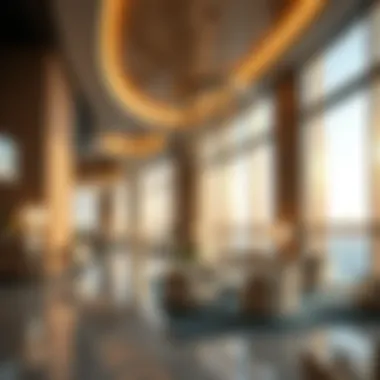
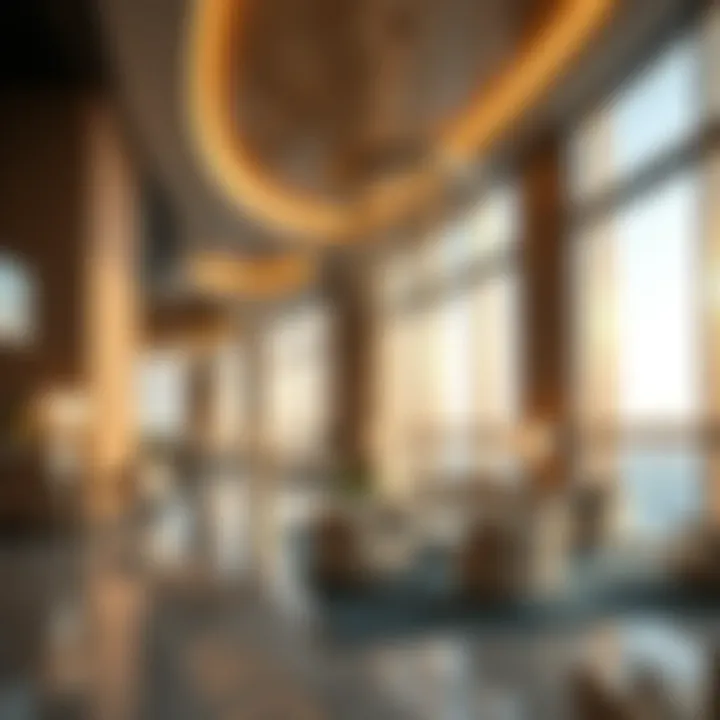
Influences on Property Prices
The presence of the W Tower has undeniable implications for property prices in the surrounding areas. Its upscale branding attracts high-caliber clientele, leading to a noticeable increase in demand for residential and commercial spaces nearby. This increase is not only limited to direct proximity but reverberates throughout the skyline, lifting the perception of luxury across the entire district. For instance, properties within a few blocks of the W Tower have seen substantial appreciation.
Factors such as architectural prestige and a vibrant location contribute significantly to these changes. The tower’s global recognition establishes its unique status, thereby encouraging neighboring developments and investments. Buyers are willing to pay a premium for properties that share an aura of exclusivity associated with the W Tower. The more desirable the location becomes, the higher the property prices set by the market, leading to a ripple effect in valuations.
Key factors influencing these property prices include:
- Proximity to the W Tower and its associated amenities.
- The overall image and branding of the W in Dubai’s skyline.
- Investor perception about the future growth potential of the area.
- The appeal of luxury features and services offered in the vicinity.
The correlation between high-end landmarks like the W Tower and local property prices emphasizes the importance of strategic investment in these well-established locales.
Investment Opportunities
Investors eyeing the Dubai real estate market will find the W Tower an attractive landmark that signals various opportunities. Beyond residential investments, the area is burgeoning with commercial prospects, particularly in hospitality and retail sectors. As the W Tower's popularity soars, demand for short-term rentals and luxury accommodations rises, presenting lucrative opportunities for property managers and individual investors.
Potential developments in and around the W Tower are worth noting:
- Hospitality Ventures: High-end hotels and serviced apartments designed to cater to the affluent traveler.
- Retail Spaces: Boutique shops and fine dining establishments that capitalize on the elegant allure perpetuated by the W branding.
- Office Spaces: Modern workspaces attracting creative businesses and startups, drawn to a dynamic urban setting.
"The W Tower is much more than a luxury experience; it is a catalyst for growth in Dubai’s diverse real estate sector."
Investing near the W Tower means tapping into a lifestyle that international buyers value highly. This presents a dual opportunity for returns on investment both through appreciation and rental yields. As the real estate scene continues to develop around such iconic landmarks, prudent investors will keep a watchful eye on the W Tower’s influence, recognizing its part in shaping future trends.
In summary, the W Tower not only redefines luxury living in Dubai but also serves as a powerful force impacting property values and guiding investment strategies in the dynamic real estate market.
Sustainability Aspects of the W Tower
Sustainability in modern construction has become not just a trend but a necessity. The W Tower is a prime example of how innovative design can address environmental concerns while maintaining aesthetic appeal. By incorporating sustainable practices and materials, the Tower stands as a beacon of forward-thinking in Dubai's architectural landscape. This section delves into the pivotal sustainability aspects of the W Tower, highlighting why it matters, the initiatives taken, and how it sets a precedent for future developments.
Energy Efficiency Initiatives
The W Tower has implemented several energy efficiency initiatives that set it apart from traditional buildings. First off, the use of advanced energy management systems plays a crucial role in optimizing energy consumption. By strategically placing sensors and automated controls, the building effectively adjusts lighting, heating, and cooling conditions based on real-time occupancy. For instance, during peak daylight hours, the system automatically dims artificial lighting, reducing electricity usage significantly.
Moreover, the incorporation of high-performance glazing not only enhances the Tower’s exterior but also provides insulation that minimizes heat gain. This feature is particularly relevant in the desert climate of Dubai, helping reduce reliance on air conditioning and, consequently, decreasing the overall carbon footprint of the building.
The use of renewable energy sources is also noteworthy. Solar panels are integrated into the design, generating clean energy onsite. These panels help offset energy consumption while contributing to Dubai's aspirations of becoming a leader in sustainable living. In fact, a portion of the building's energy is sourced from these panels, which is an added win for both the environment and operating costs.
Green Certification and Standards
Achieving green certification is no small feat, and the W Tower has undergone rigorous assessments to secure numerous environmental accreditations. It adheres to the Leadership in Energy and Environmental Design (LEED) criteria, a globally recognized standard for sustainable buildings. This certification encompasses various factors, including energy efficiency, water conservation, and indoor environmental quality.
Furthermore, the Dubai Green Building Regulations plays a critical role in driving sustainable architecture within the region. The Tower not only complies with these local standards but goes above and beyond, often becoming a model for other developers in Dubai. The use of eco-friendly materials, along with a commitment to waste reduction strategies during construction, has elevated the building's status in terms of sustainability.
As a result, this focus on sustainability has diversified the building’s appeal among a broader audience. Investors and homebuyers increasingly prioritize eco-friendly features, driving demand for properties like the W Tower that align with these values.
"Sustainability is not just a buzzword; it's a fundamental shift in how we approach building design moving forward. The W Tower captures this shift beautifully."
Through these initiatives and certification pursuits, the W Tower unmistakably demonstrates that luxury and sustainability can go hand in hand, inspiring a new wave of architectural innovation in Dubai and beyond.
Cultural and Social Dimensions
The W Tower stands not just as a magnificent architectural feat, but also as a deep-rooted piece of Dubai's cultural tapestry. Examining its cultural and social significance allows us to understand not only what the tower represents in a physical sense, but also how it influences and integrates with the lives of the people around it. The W Tower is not merely a building; it embodies the evolution of Dubai's identity, reflecting both local heritage and cosmopolitan modernity.
W Tower as a Cultural Landmark
In a city like Dubai, where tradition meets innovation, the W Tower serves as a vivid cultural landmark. Its design draws inspiration from local motifs and Islamic geometric patterns, achieving a synthesis of the old and the new. Visitors can often be spotted taking photographs against its striking facade, showcasing both admiration and the sentiment that this structure, rising high against the skyline, is part of their narrative.
Moreover, the tower has become a hub for various cultural events. Art exhibitions, fashion shows, and culinary festivals frequently take place in its spaces, making it a focal point for creative expression in the city. This is a place where cultures converge and interact, celebrating both heritage and modernity. It even plays host to events celebrating Emirati traditions, which helps in reinforcing a sense of identity for both residents and tourists.
Community Engagement and Events
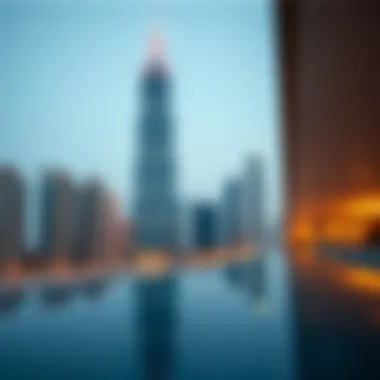
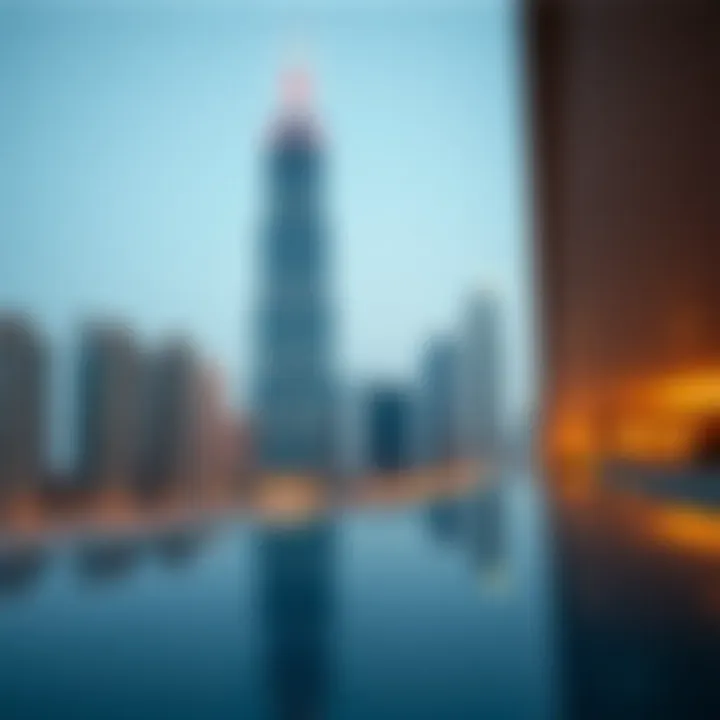
The impact of the W Tower extends into the community as well. Through initiatives that encourage local engagement, the tower acts as a bridge connecting different demographic groups. For example, there are programs aimed at fostering young artists and entrepreneurs, providing them with platforms to showcase their work. This kind of support is crucial in a city that thrives on innovation and creativity.
Events hosted at the W Tower often gather people from all walks of life, promoting social cohesion and interaction. Whether it’s weekend markets featuring local artisans or open-air movie nights, these gatherings foster a sense of belonging among residents. The multicultural nature of Dubai is palpable in these events; you can sense it in the food, the music, and the conversations that echo in the lobby of the tower.
"The W Tower not only anchors the skyline but also connects people, creating a shared experience that transcends mere physical space."
The importance of these elements should not be underestimated. In a city often seen as a transient space filled with expatriates, the W Tower provides a sense of home for many. It serves as a reminder that while Dubai is always evolving, it holds on to its cultural heritage and continually builds on it, making it a true social landmark in the heart of the city.
Challenges and Controversies
The W Tower, while undeniably a striking element of Dubai's skyline, has not sailed without encountering its fair share of challenges and controversies. Understanding these aspects sheds light on the complexities involved in constructing and sustaining such an architectural marvel. The dialogue surrounding the W Tower encapsulates not just architectural critique but also broader implications about urban development, regulatory frameworks, and community perception. By addressing these controversies, one gains a nuanced perspective of how a single structure can mirror the dynamics of a vibrant, yet occasionally contentious, urban landscape.
Architectural Criticism
Critics have not held back in voicing their opinions about the W Tower's design and architectural ethos. Some architects and design commentators argue that it strays too far from traditional styles that respect Dubai's rich cultural heritage. They suggest that the building's ultra-modern design, with its gleaming facade and unconventional shapes, might alienate those who favor aesthetics grounded in local history and authenticity.
Moreover, some feel the structure represents a shift towards a more globalized, homogenized architecture that lacks a distinctive identity. Yet, others point out that such innovation is essential for a city constantly evolving to assert itself on the world stage. The debate can be framed around the broader conversation of balancing progress with cultural preservation. This criticism invites investors and potential homeowners to consider the implications of design choices on property value and community acceptance, with some worried that overly bold architecture may inadvertently dampen the neighborhood's overall charm.
Construction and Regulatory Issues
In terms of construction, the W Tower has not been exempt from various setbacks and regulatory hurdles. Projects of this scale often face scrutiny regarding compliance with building codes and safety regulations. The initial phases were delayed due to concerns about materials used and structural integrity. Ensuring the building met standards for seismic activity, among other factors, proved to be a complicated affair. Additionally, issues around labor rights and the treatment of workers contributed to vocal concerns during construction.
Beneath these controversies lies a critical examination of governance and how urban planning is navigated within a rapidly changing context. The W Tower's journey through the regulatory labyrinth serves as a case study for other architects and developers aiming to tread the delicate line between innovation and compliance. It also highlights the need for ongoing dialogues among stakeholders—regulators, designers, and the community—to create a future where visionary architecture can thrive alongside practical realities.
The journey of the W Tower underscores that every architectural landmark is, in many ways, a reflection of its time, caught between ambition and its socio-political environment.
Understanding these challenges is essential for stakeholders— investors, homebuyers, and urban planners— as it enriches their comprehension of what such complexities entail for the future of urban development in Dubai.
Future Prospects for the W Tower
The W Tower stands as a bold symbol of modern architecture in Dubai, but its future is equally as intriguing as its past. Given the rapid pace of urban development in the city, understanding the future prospects of the W Tower becomes vital for various stakeholders including investors, homebuyers, and urban planners. The potential transformations and opportunities surrounding the W Tower will highlight its enduring relevance and impact on Dubai's skyline and real estate landscape.
Market Predictions
Looking ahead, market predictions for the W Tower suggest a vibrant trajectory influenced by multiple factors. As the city's infrastructure continues to evolve, the demand for luxury living and commercial spaces in prominent locations like the W Tower is set to grow.
- Increased Investments: Recent studies indicate a surge in foreign investments, particularly in Dubai’s high-end real estate market. The W Tower's prime location and unique offerings are likely to attract both local and international investors.
- Rental Trends: Analysts predict that rental prices for luxury apartments in the W Tower could see an upward trend. This arises from the projected influx of expatriates and affluent tourists seeking high-quality accommodation in the heart of Dubai.
- Technological Integration: Technological advancements, including smart home features and sustainable design practices, are becoming increasingly important. With the world leaning towards eco-friendly living, developments in the W Tower may place it at the forefront of modern residential trends.
The collective impact of these trends is expected to not just maintain the W Tower's stature but possibly enhance its position in the competitive real estate market.
Potential Developments
Various developments are on the horizon which could radically shape the W Tower and its surrounding area. These developments not only enrich the urban fabric but also elevate the stature of the Tower as a key player in Dubai’s future.
- Commercial Expansion: Plans for additional commercial spaces nearby could enhance the W Tower's appeal as a landmark destination for business and leisure. An increase in retail and entertainment options would attract more visitors and residents alike.
- Infrastructure Updates: Upcoming projects like expanded transit systems and enhanced road networks are also in discussions. These improvements could directly affect accessibility to the W Tower, making it an even more attractive option for potential residents and businesses.
- Sustainability Initiatives: With the world shifting towards green practices, the W Tower may consider incorporating more environmentally-friendly features.
- Cultural Events: Hosting cultural events and exhibitions within or around the tower can increase its visibility and relevance in the cultural domain of Dubai, fostering community engagement.
With these prospects, the W Tower stands at a pivotal point, and the decisions made today may influence its role in shaping Dubai’s architectural and economic narrative for decades to come.
"As the W Tower continues to evolve, it embodies the growth of Dubai as a leading global city while offering insights into future real estate trends and architectural innovations."
Overall, monitoring these future prospects emphasizes the importance of adapting to market dynamics and consumer preferences in Dubai's ever-evolving real estate scene.
The End
The conclusion of the article provides a vital encapsulation of everything discussed regarding the W Tower. Its significance goes beyond just being a striking silhouette against the Dubai skyline; it embodies the potential and the complexities of modern architectural aspirations within urban areas. The W Tower's design integrates sustainability and innovative technology while serving as a cultural and economic beacon for the region. For investors and homebuyers, understanding these elements can enhance decision-making by revealing the intricate interplay between architecture and the real estate market.
Summary of Key Insights
- Architectural Brilliance: The W Tower stands as an example of cutting-edge design and engineering. Its facade, with a mesmerizing blend of glass and steel, not only contributes to aesthetic pleasure but also reflects a deeper commitment to sustainability.
- Economic Influence: As the W Tower rises, so do its contributions to property valuations in the surrounding district. Investors should keep a close eye on how this architectural marvel shapes buyer preferences and investment trajectories.
- Cultural Significance: The Tower is not merely an edifice; it's a cultural landmark that invites community engagement and fosters social events, ultimately enhancing its status as a galvanizing point for the city’s cultural narrative.
- Market Trends: As analyzed, the impact of the W Tower on market predictions suggests an upward trend in property values. Understanding these signals can guide potential investments efficiently.
"Buildings are a reflection of the society that creates them, and the W Tower is no exception."
Final Thoughts on the W Tower's Impact
While the W Tower may initially grab the eye with its striking architecture, the real story lies within its multifaceted impact. This structure is a testament to the ever-evolving nature of Dubai, where tradition meets modernity. Its comprehensive analysis, reflecting both challenges and opportunities, provides investors and homebuyers with the knowledge necessary to navigate the tight-knit and competitive real estate landscape. As Dubai continues to flourish, the W Tower will undoubtedly remain a focal point, influencing trends and consumer sentiments for years to come.
As an epitome of architectural prowess, the W Tower invites further exploration into what makes a modern city thrive. Understanding the connection between such landmarks and urban identity may be the key to robust investment strategies moving forward.




